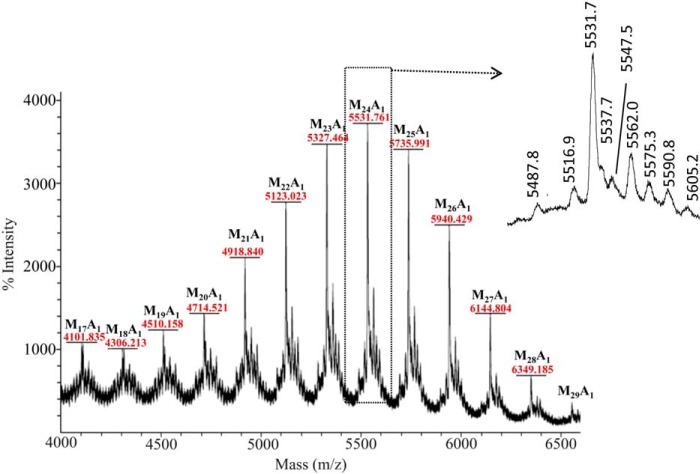FIGURE 4.
The positive ion MALDI-TOF MS methylated “LM-like” polymer produced by M. smegmatis ΔMSMEG_6387. The phosphatidylinositol is de-esterified and methylated as shown for LM13 in Fig. 1. The M+Na+ ions of species, which contain a single arabinosyl residue and 17–29 mannosyl residues attached to a methylated inositol-phosphoryl-glycerol (Inos-P-Gro), dominate the spectrum. At lower m/z values (data not shown), methyl glycosides of mannosyl oligomers plus and minus a single arabinosyl are found. The methyl glycoside series with the single arabinosyl unit persist up to Ara1Man26 (see the ion at m/z 5537.7 in the inset (mass off by 1 atomic mass units). The formation of these ions is not understood; they might be fragment ions from the higher mass ions or actual oligomers that formed before or during the methylation procedure; in either case it seems likely that somehow they were derived from the parent LM-like molecule. Each major Ara-Mann-Inos-P-Gro is surrounded by ions of 44 and 14 atomic mass units lower in mass and 16, 44, and 60 atomic mass units higher in mass as shown for the sodiated ion resulting from Ara1-Man24-Inos-P-Gro at m/z 5531.3. We cannot explain these ions with any degree of certainty. The ion at m/z 5516.9 is consistent with sodiated Ara1-Man24-Inos-P-Gro with a single OH group from under-methylation. The ion at m/z 5487.6 is consistent with sodiated Ara2-Man23-Inos-P-Gro and the ion at m/z 5575.3 with sodiated Man25-Inos-P-Gro. If these assignments are correct, very occasionally two arabinan chains could be present on LAM, and in this mutant some non-arabinosylated LM might be present. However, given their very weak intensity and the inexplicable ions at m/z 5547.058, m/z 5562.023, and m/z 5590.8, these assignments must be considered tentative.

